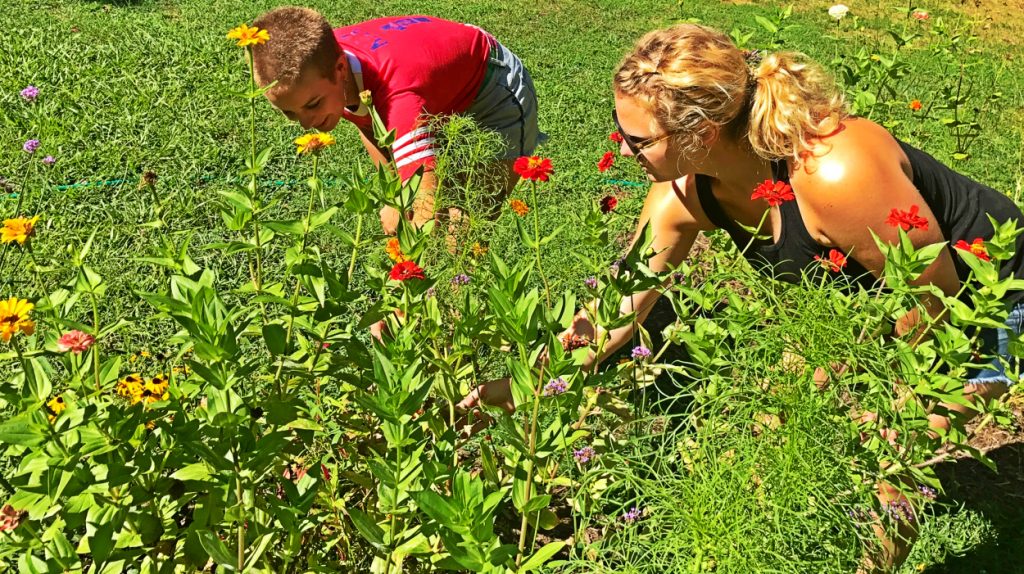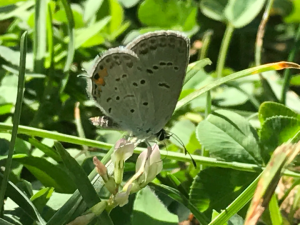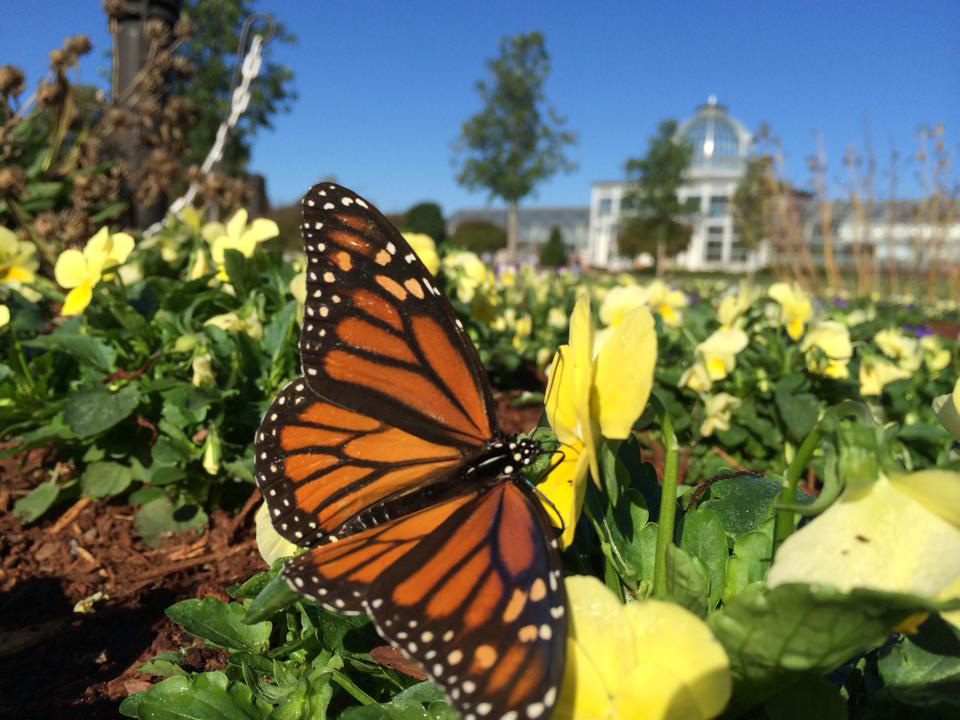Butterfly Garden Pro!
For this month’s blog I’d like to demonstrate how simple, straight-forward, and fun creating a butterfly garden is. I asked around the horticulturist’s lunch table to find out who among them ranks as a butterfly gardening expert. I’m glad I did, because Senior Horticulturist Shannon Smith is a butterfly gardening pro and plants specifically to support our native pollinators both here at Lewis Ginter and in her home garden. I also learned a lot about sustainable cultivation from Conservatory and Kroger Community Kitchen Garden horticulturist, Chelsea Mahaffey. But first, before we find out how their gardens grow, let’s talk butterfly garden basics.

Allie Hawley, left, and Sally Acors, right, look over some of their butterfly garden’s nectar plants.
A Butterfly Garden as defined by the North American Butterfly Association (NABA)
The North American Butterfly Association has some clear and easy-to-follow guidelines on what defines a butterfly garden, as well as the opportunity to officially certify yours! According to NABA a butterfly garden must have have:

We love white clover (Trifolium repens) even though its not technically a native. It increases soil fertility and is the preferred host and nectar plant for Eastern-tailed blue butterflies.
Three native host plant, Three native nectar plants and an area without pesticides that could harm butterflies.
Naturally, your butterfly garden can have more than three native host and nectar plants. Three is just the minimum required. For more practical and useful information about Virginia’s native plants I encourage you to visit Lady Bird Johnson Wildflower Research Center’s recommended plants for Virginia or take a look at our blog post and plant list for the Morton Native Plant Garden right here at Lewis Ginter.
Smith’s Butterfly Garden Picks
Horticulturist Shannon Smith shared with me that she was planting her garden full of plants to support and attract all of the native pollinators — for butterflies…and beyond! Her hot tip for anyone looking to attract the ruby-throated-hummingbird was to plant salvia (Salvia guarantica) ‘Black and Bloom’. The hummingbirds go crazy for it, and it’s a beautiful addition to any garden.
Three native host plants: Swamp milkweed (Asclepias incarnata), violets (viola app.) and wild cherry (Prunus serotina).
Three native nectar plants: Bee balm ‘Jacob Cline’ (Monarda didyma), giant hyssop ‘Black Adder’ (Agastache spp.) and cardinal flower (Lobelia cardinalis).
Mahaffey’s Butterfly Garden
Horticulturist Chelsea Mahaffey likes to use perennials as fixtures in her plantings scheme and finds the most joy in starting annuals from seed each year. Some of her notable butterfly favorites are cosmos, zinnia, and tithonias, because they provide a big splash of color and last the whole season long.
Three native host plants: “Butterfly weed, butterfly weed, butterfly weed.” Seriously though, any of the native Asclepias species grow great around here and provide invaluable caterpillar food for the monarch butterfly, as well as the milkweed tussock moth and a host of other specialized insects. It’s doubly important due to its excellent nectar production, too. Butterfly weed (Asclepias spp.) is a workhorse of a plant, and we recommend planting a couple of different types to find out which one works best in your butterfly garden.
Three native nectar plants: Liatris (Liatris spicata), hoary mountain mint (Pycnanthemum incanum) and Joe-Pye weed (Eutrochium fistulosom).
Butterfly Gardening with Friends
I also wanted to get the inside scoop from my friends and fellow plant people, Allie Hawley and Sally Acors. They both work at Sneed’s Nursery and have a way of bringing work home with them…in the best possible way! Their yard is literally abloom with life and they demonstrated how fun and multi-functional butterfly gardening really is.
Hawley and Acors’ Butterfly Garden Picks
Three native host plants: Tulip poplar tree (Liriodendron tulipfera), nettles (Urtica spp.) and loblolly pine (Pinus taeda).
Three native nectar plants: Golden tickseed (Coreopsis tinctoria), purple coneflower (Echinacea purpurea) and black-eyed Susan (Rudbeckia hirta).
Bonus: Both Echinacea and black-eyed Susan double as host plants too!
Butterfly Safe Management
All the gardeners I spoke with emphasized the importance of sustainable and organic practices, such as composting, companion planting and cover cropping. They also mentioned the importance of leaving some areas un-mowed, and only using chemical pesticides and herbicides only when there is no other alternative.
Butterfly Garden Features
As we all know, food isn’t the only requirement of living things. As with any other wildlife garden, we must be sure to supply water, shelter and protection. Butterflies are no exception.
Water — Butterflies take their water with dissolved salts and micro-minerals. “Puddling” is when butterflies gather on disturbed ground, gravel, or sandy areas (such as a stream bank). Butterfly watchers know that one of the best times to observe butterflies up close is when they are preoccupied with puddling. Butterflies aren’t picky when it comes to their water source, the most important thing is that it be reliable. If a small pond isn’t possible for you, you might consider investing in a soaker hose and timer. This method conserves more water and delivers it more efficiently, on the regular for both butterflies and plants.
Shelter — Butterflies require areas for rest and relaxation, just like you and me. One of the best ways that we can be sure to provide the right type of environment for them is to provide as many various micro-habitats as possible. Utilizing these elements of micro-habitats also will help integrate many more dimension of landscape design. It’s a win-win! So be sure to garden with layers and make room in your garden for plants of all heights. The more layers your garden has the more species will be able to find a home there. Increase your edge with meandering borders or island beds. Edges are some of nature’s more active and highly populated areas.
Protection — Provide dense cover to keep butterflies out of harsh winds and rains and to help them evade predators. Here is where you want to think about: wind breaks, hedgerows and wildlife corridors.
Butterfly gardening is a pure and uncomplicated hobby. The entire purpose of the butterfly garden is to attract and nourish these four-winged beauties and to cultivate a personal awareness and connection with the natural world. It’s a fun activity to share with friends and family. Not to mention, it’s incredibly positive and meaningful impact within our local ecology.
If you want to see a certified butterfly garden for yourself, be sure to stop by the Monarch Waystation in our Children’s Garden. It’s the perfect time of year to see our favorite migrant nectaring among the flowers, and you might even catch a glimpse of its striped larvae munching upon milkweed leaves.